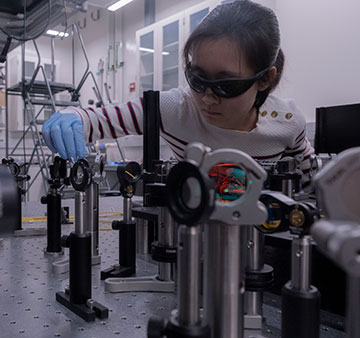
Zixi Li is the co-first-author on a new paper from the lab of Alex High, which demonstrates a new way to provide more powerful measurements on the atomic level. [Image: Photo by Hong Qiao / UChicago Pritzker School of Molecular Engineering]
Optical antennas—which convert the energy of free propagating radiation to localized energy, and vice versa—have emerged as a promising technology in the last decade. These analogs of radio frequency antennas have the ability to enhance efficiency in a broad range of applications, including communications, sensing and spectroscopy.
Now, researchers in the United States and Spain have demonstrated that germanium vacancy centers (GeVs) in diamonds have unique properties that make them ideal optical antennas (Nat. Photon., doi: 10.1038/s41566-024-01456-5). The GeV antenna showed up to a millionfold optical intensity enhancement at the atomic scale, which sets a record well beyond the achievable limit through plasmonic structures.
Solid-state optical antenna
Theoretically, any atomic dipole in a solid will function as an antenna under resonant excitation. The intensity of the resulting evanescent near field increases with decreasing distance down to length scales comparable with the size of the atomic orbitals. However, atomic dipoles in solids typically suffer from limited driving efficiency due to phonon scattering and other disruptive environmental processes.
Over the past decade, researchers have observed exceptional optical coherence in several solid-state quantum defects, and some color centers can be immune to these environmental effects. Alex High at the Pritzker School of Molecular Engineering, University of Chicago, USA, and his colleagues decided to investigate the possibility of leveraging one type of color center, GeVs, to create a solid-state optical antenna.
“Typically, [these properties are] harnessed for quantum networking and experiments in distributed entanglement,” said study author High. “Here, our motivation was to explore an alternative modality for optically coherent defects, in which the optical response itself is used as an antenna to sense and manipulate its proximal environment.”
Higher amplification with no loss
Compared with traditional plasmonic antennas, the GeV antenna has much higher amplification when active, does not have ohmic losses and requires minimal operation power.
In the current study, the researchers focused on the zero-phonon line transition between the lower ground and excited states. Upon illumination by a resonant input field that is polarized along the GeV dipole axis, the scattered optical field can become much more intense than the resonant excitation field, with the enhancement in intensity reaching magnitudes of 108 at distances of 1 nm or less.
Compared with traditional plasmonic antennas, the GeV antenna has much higher amplification when active, does not have ohmic losses and requires minimal operation power. Typical plasmonic antennas demonstrate limited field enhancement on the order of 1,000 to 10,000. The GeV antenna also has a much narrower operation bandwidth, which provides more signal selectivity and avoids the effects of background noise.
“We show that this near-field intensity can measure and manipulate local carbon vacancies, and even be used to efficiently transfer energy between the two systems,” said High. “These antennas are composed of single atoms, can live deep inside materials or at surfaces and can be engineered to be in proximity to sensing targets, all of which can lead to interesting potential applications in sensing and measurement of nanoscale phenomena.”
In the near future, High and his colleagues aim to explore the integration of these optical antennas with other nanophotonic structures to develop more functional devices. They also wish to investigate other types of atomic and molecular systems with excellent optical coherence at room temperature to extend the study to a broad range of solid-state systems.
